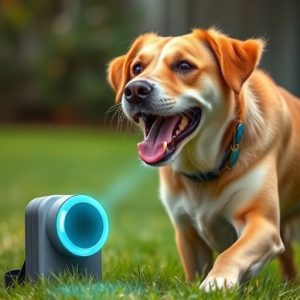Dog Repellent Devices: Understanding Ultrasonic Systems & Effective Compliance Testing
Canine behavior modification using dog repellent devices, especially ultrasonic systems, relies on o…….
Canine behavior modification using dog repellent devices, especially ultrasonic systems, relies on operant conditioning and positive reinforcement. These devices emit safe, high-frequency sound waves to deter unwanted behaviors without harm. Strict compliance testing ensures their safety and effectiveness, meeting regulatory standards. Testing simulates various scenarios to verify deterrence while adhering to ethical guidelines for responsible pet ownership. Strategic planning is crucial for device implementation; maintenance and adjustments are vital for adaptability in different environments.
“Unleashing the Power of Sound: Exploring Canine Behavior Modification with Ultrasonic Systems”
Canine behavior modification is a science-backed approach to training dogs, focusing on understanding their unique behaviors. Among various tools, Dog Repellent Devices (DRDs), particularly ultrasonic systems, have gained attention for their ability to deter unwanted actions. This article delves into the concept, exploring the science behind canine behavior modification and the effectiveness of DRDs, specifically ultrasonic devices. We examine compliance testing crucial for ensuring safety and efficacy, and provide practical considerations for implementation across diverse environments.
- Understanding Canine Behavior Modification: The Concept and Science Behind It
- Dog Repellent Devices: How Ultrasonic Systems Work and Their Effectiveness
- Compliance Testing for Dog Repellent Devices: Ensuring Safety and Efficacy
- Practical Application and Considerations: Implementing the Ultrasonic System in Different Environments
Understanding Canine Behavior Modification: The Concept and Science Behind It
Canine behavior modification is a scientifically-driven approach to understanding and reshaping a dog’s actions, often using positive reinforcement techniques. This method leverages the principle that dogs, like many other animals, respond to environmental cues and stimuli, learning to associate certain behaviors with rewards or consequences. By carefully controlling these stimuli, trainers can modify unwanted behaviors and encourage desirable ones.
At the heart of this process lies the concept of operant conditioning, where dogs learn from the immediate effects of their actions. A dog repellent device, for instance, could be used as a tool during behavior modification training. These devices often emit ultrasonic sounds or vibrations that are harmless but unpleasant to dogs, serving as a negative reinforcement when the animal displays unwanted behavior. Compliance testing is crucial here; ensuring these devices meet safety standards and effectively deter pets without causing harm or distress is paramount. Through such tests, researchers can validate the science behind these systems, refining their design and application for optimal canine behavior modification.
Dog Repellent Devices: How Ultrasonic Systems Work and Their Effectiveness
Dog repellent devices, especially ultrasonic systems, have gained popularity as humane alternatives to traditional shock collars for behavior modification. These innovative tools emit high-frequency sound waves that are unpleasant to dogs but harmless to their sensitive hearing. The principle behind their effectiveness lies in the dog’s ability to associate the ultrasonic noise with an aversive experience, thus deterring unwanted behaviors.
Ultrasonic systems have shown promise in various studies and real-world applications. Compliance testing for Dog Repellent Device Certification ensures these devices meet safety standards. Multiple trials have demonstrated their success in reducing barking, improving recall, and modifying aggression without causing physical harm or stress to the animals. Their non-invasive nature makes them suitable for dogs of all ages and breeds, making ultrasonic systems a preferred choice for responsible pet ownership and professional trainers alike.
Compliance Testing for Dog Repellent Devices: Ensuring Safety and Efficacy
Compliance testing is an integral part of ensuring the safety and effectiveness of dog repellent devices, including ultrasonic systems. These tests are designed to verify that the product meets specific standards and regulations, especially when it comes to controlling canine behavior. The process involves rigorous assessments to guarantee that the device emits sounds or signals at safe levels, without causing harm or discomfort to dogs. By simulating various scenarios and environments, experts can determine if the repellent system operates as intended, deterring unwanted dog behavior while adhering to ethical guidelines.
During compliance testing, researchers may evaluate factors such as sound pressure level, frequency range, and duration of ultrasonic emissions. These tests are crucial in mitigating potential risks, ensuring the well-being of animals, and providing peace of mind for owners. Moreover, it helps manufacturers maintain high-quality standards, fostering consumer trust and confidence in the product’s ability to address dog behavior issues effectively and humanely.
Practical Application and Considerations: Implementing the Ultrasonic System in Different Environments
Implementing an ultrasonic dog repellent device in various environments requires careful consideration and planning to ensure its effectiveness and safety. These systems are designed to emit high-frequency sound waves that are unpleasant to dogs, encouraging them to avoid certain areas. When introducing such a device, it’s crucial to assess the space and potential distractions. For instance, in outdoor settings, the device should be placed strategically to target specific problem areas while ensuring compliance with local regulations regarding noise levels and disturbance to neighbors or wildlife.
Different environments present unique challenges. Urban apartments may require more focused, targeted coverage due to limited space and potential interference from neighboring units. In contrast, large rural properties demand a comprehensive system that can effectively deter dogs over extensive areas. Compliance testing is essential to ensure the device operates within safe sound pressure levels and adheres to legal guidelines. Regular maintenance and adjustments are often necessary to adapt to changing conditions, ensuring the repellent’s longevity and continued effectiveness in modifying canine behavior across diverse settings.
The canine behavior modification ultrasonic system offers a safe, effective, and non-invasive solution for managing dog behavior. By understanding the science behind it and ensuring proper device compliance testing, pet owners can harness the power of these innovative tools to create positive change in their dogs’ behavior. When implemented correctly, this technology allows for a more harmonious coexistence between pets and their environments, making it an appealing choice for those seeking alternative training methods.


